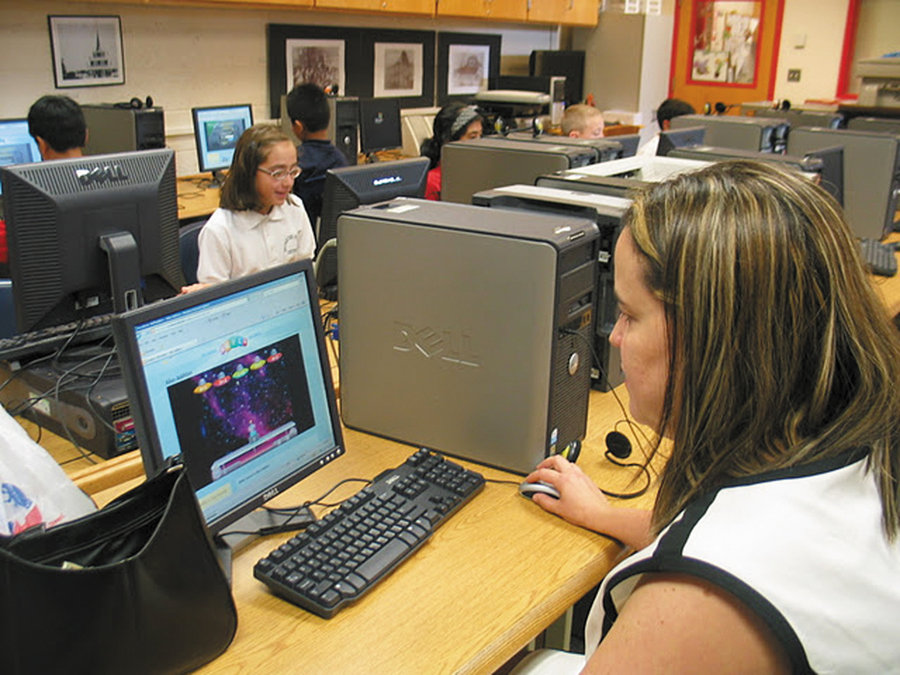Inside Anna Leppin’s classroom, pink, purple, green and red backpacks hang inside designated cubbies, while cutouts of giraffes, elephants and lions surround lettering saying “We’re Wild About Pre-K.” Students work and play in “centers” such as the kitchen area, blocks area and Legos area.
“They develop social skills by working in small groups,” said Leppin.
Schools Superintendent Cynthia Randina gave a walk-through the elementary schools and the district’s new Early Learning Center last month, showing classrooms brightly decorated with autumn themes and students actively learning math and writing in creative, modern ways.
The pre-kindergarten moved into the new Early Learning Center space in September from Huber and Clarendon Elementary schools after the town shut down the town-run day care, which was losing money. The town and Board of Education held a ribbon cutting ceremony last week.
“The kids get very motivated. They don’t realize that they are just doing math.” – Anna Boscarino
____________
The hallways were painted in bright, light blue colors with images of trees and autumn leaves.
Leppin’s students were participating in Red Square Week, in which a big topic was apples. Kids balanced apples on their heads to further develop gross and fine motor skills.
Leppin has been an educator for 13 years, eight of those as a pre-kindergarten teacher.
Tasting and hearing colors through poetry
While pre-kindergartners balanced apples on their heads, fourth graders at Huber Street Elementary School explored the redness of apples in a poetry writing exercise (see sidebar).
“Red is an apple, but go on from that,” said Kelly Ingenito, fourth grade teacher in her seventh year of teaching. After reading the book, “Hailstones and Halibut Bones” by Mary O’Neill, Ingenito asked her classroom to brainstorm a color then write and generate a list of descriptions, which the students typed up on their computers. They finally painted an image to go along with the poetry.
“[The assignment] is a challenge because how do you taste purple or hear purple?” said Ingenito. “It is a great beginning of the year [exercise].”
“I don’t like fill in the blanks. I like to see student’s true performance,” said Randina. She said a specialist came in last year to institute the Collins Writing program, which is based on work by John Collins, Ed.D, founder of the Collins Education Associates (CEA). The specialist worked with grades 3 to 8.
The program expanded to the first and second grades this year.
“The focus is on generating real responses from the students and not focusing on the errors,” she said. “We let students express themselves and then we go through the editing process. We found that it is more successful and kids love it.”
According to CEA, Collins Writing is based on two essential principles: thinking and writing skills develop with experience and practice, and it is almost impossible to be both a creative thinker who generates new ideas and a critical thinker who evaluates existing ideas at once.
Interactive learning
Over at Clarendon Elementary School, second graders in Michelle Primavera’s class participated in a group activity and raised their hands to answer math questions that appeared on the Promethean board, an interactive learning whiteboard that connects to a computer.
Math Coach Rob Valenti said a new math program, Envision Math, had begun in the primary grades. The program includes digital lessons and homework on the computer. The Promethium board gives teachers the flexibility to include supplemental work. He said the board allows for active votes, through which students use a handheld remote to enter their answers.
“You can create your own assessment on the Promethean board…and export the information to an excel file,” said Valenti.
Zooming through multiplication
“In fifth grade you really have to know [multiplication] automatically. A lot of [students] don’t know it fluently,” said Anna Boscarino at Huber Street. She has been teaching for 13 years.
Her students sat at computers playing what looked like a racecar video game, but it was really an exercise in multiplication. Boscarino found a web site, Arcademic Skill Builders, which is a multiplayer educational gaming site.
Students had one minute to go through a series of multiplication problems. If they clicked the right answer, their car moved forward. If answered incorrectly, their car slowed. The faster they answered, the faster their car went. At the end, the game displayed what problems students answered wrong with the correct answers.
“The [students] are playing against each other and basically they have to do fluency and maintenance,” she said. “This is a fun way to teach it…The kids get very motivated. They don’t realize that they are just doing math.”
Adriana Rambay Fernández may be reached at afernandez@hudsonreporter.com.
SIDEBAR
What is Orange?
WHAT IS ORANGE?
By Syeda Fatima
Huber Street Elementary School
Kelly Ingenito’s Fourth Grade
What is Orange?
Orange is an orange on your kitchen table.
Orange is sweeter than a honeybees honey.
Orange is candy from the awesome candy store.
Orange is a sunset sweet and light.
Orange is a fierce fox prowling around the field.
Some young girls paint their fingernails orange.
Orange is soap smelling so divine.
Orange is a big jack-o-lantern on a spooky Halloween night.
Orange is an autumn leaf crunching underneath your feet.
Orange is an outstanding color.
Orange is perfect, simply perfect.
